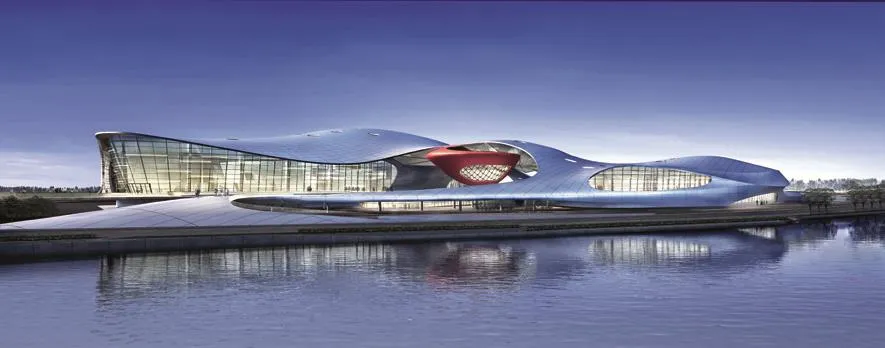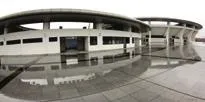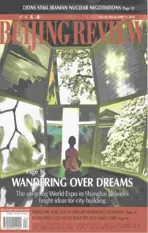Ready-set-go for the Games
2010-09-12ByDINGWENLEI
By DING WENLEI
Ready-set-go for the Games
By DING WENLEI

The artist’s concept of the completed Asian Games Town Gymnasium
Guangzhou gears up for the 16th Asian Games in November
New roads are being built. Old venues are being overhauled. Interior decorating in new venues is proceeding smoothly. Guangzhou, capital of south China’s Guangdong Province, is making its final preparations for the upcoming 16th Asian Games.
The Asian Games, the biggest multisport event for athletes all across Asia, will return to China this fall. From November 12 to 27, 2010, the subtropical city Guangzhou will host the 16th Asian Games during its most agreeable season, 20 years after Beijing hosted the 11th Asian Games in 1990.
Proven experience indicates the hosting of international sports or cultural events provides host cities a unique opportunity to rev up economic growth and urban development. Guangzhou is availing itself of this opportunity to improve its infrastructure and achieve goals of urban expansion.
In addition to borrowing successful practices from Beijing, organizers of the Guangzhou Asiad have done the work in a low-key, pragmatic and tolerant approach typical of Cantonese.
“The inclusion of as many as 14 non-Olympic sports in this event allows the event to be highly representative of all Asian countries and inspires mass participation,” Sun Xiuqing, Deputy Director of the Communication and Promotion Department of the Guangzhou Asian Games Organizing Committee (GAGOC), told Beijing Review.
While making venue arrangements, the organizers addressed the issue of post-Games commercial operations and also the utilization of new venues.
“Venues are built or renovated to make them compatible with or serve the city’s blueprints for development, in an effort to avoid redundant construction and waste of resources,” Sun said.
More than 14,000 athletes, trainers and coaches from 45 countries and regions are expected to compete in 42 sports during the event, which is themed “Thrilling Games, Harmonious Asia.” In addition, it is expected to bring to the city 6,500 technical officials, 10,000 registered media workers and 2,000 members of the Olympic Council of Asia.
The 2010 Asian Para Games will debut shortly after the conclusion of the 16th Asian Games, using the facilities and venues made accessible for the disabled.
Fairly representative
The 16th Asian Games feature 42 sports, including 28 Olympic sports and 14 non-Olympic sports that are popular in Southeast Asian countries.
“The inclusion of non-Olympic sports distinguishes the Asian Games from other multi-sport events,” said Li Xiaofeng, Deputy Director of GAGOC’s Competition Department. “We hope to make the event a festival for all Asian people and promote a coordinated development of competitive sports and mass sports by adding more non-Olympic sports to the event.”
About Guangzhou
Longitude: 12°57’ - 114°3’ E
Latitude: 22°26’ - 23°56’ N
Area: 7,434.4 square km
Population: 10.26 million
Climate: Typical subtropical, humid
Of the 14 non-Olympic sports, six are newly added for the event, including wei qi (the game of Go), Chinese chess, cricket, sports dancing, dragon boat racing and roller skating.
While sepak takraw is the national sport of Thailand, cricket ranks No.1 sport in India. Even kabaddi, a mass sport originating from India and Pakistan, is included.
“These non-Olympic sports value body dexterity rather than competitiveness, and therefore suit Asian people of all ages,” Li said.
The organizers have, since 2008, launched large-scale promotions of these sports on campuses and through cooperation with TV stations and broadcasting stations as well as newspapers.
Sustainable utilization
The Guangzhou Asiad will be held in 70 venues located in 10 districts and two county-level cities in Guangzhou’s jurisdiction and three nearby cities.
“We want to turn Guangzhou into a multi-center city and that’s why we have multiple centers and functions in the network of venues,” said Gong Haijie, Deputy Director of GAGOC’s Venue and Equipment Department.
The four cities where the venues are located are linked by an urban rail system and 80 percent of the venues in Guangzhou will be accessible via subway.
“We took into consideration both the needs of the Games and Guangzhou’s urban development blueprint during venue planning and construction. We hope to improve the city’s supporting infrastructure with all these new venues,” Gong said.
The GAGOC has a team working on feasible plans for new venues’ post-eventutilization, as commercial operation of large and comprehensive sports venues following the events for which they were built remains a tricky problem worldwide.

The Asian Games Town Gymnasium (under construction)

Guangdong Olympic Tennis Center
T h e g o v e r n m e n tfunded Asian Games Town serves as a nice footnote to Guangzhou’s practicality in venue arrangement. With a focus on post-Games functions, the project was designed as an all-function satellite city.
Buildings and facilities in this housing complex will mainly serve as non-competition venues, including the athletes’, technical officials’ and media villages and the main media center, the logistics area, the gymnasium and the Asian Games Park. They will be turned into apartments, shopping malls, hospitals, kindergartens and parks after the Asian Games.
With a lot of eco-friendly technology employed in construction and interior decoration, the town will become a pilot living community for the city’s southward expansion strategy.
The GAGOC was reported to have sold all buildings of the projects, except for public facilities, to an alliance of property developers for future commercial operation at 25.5 billion yuan ($3.7 billion).
In addition to 12 new venues, 58 existing sports venues in Guangzhou and nearby cities will serve the event through adaptive renovation.
“It is one of our goals that citizens will benefit most from the Games after the event,” Gong said.

Security concerns
Security is another important concern for the GAGOC as Guangzhou accommodates a migrant population much larger than its permanent population.
“Guangzhou is a much safer city now,”said Zhang Zhengui, Deputy Director of GAGOC’s Department of Security Guarantee. The city has witnessed doubledigit decreases in crimes, and marked decreases in occurrence of traffic accidents and fres since 2004.
Being south China’s manufacturing hub and attracting large numbers of migrant workers, Guangzhou has accumulated a wide range of experiences in managing migrant populations, Sun said. These include incentives that encourage migrant workers to be regular residents in order to obtain permanent residence permits, medical insurance and other social welfare.
The GAGOC also adopts successful practices from the Beijing Olympic Games, such as the introduction of crisis management schemes.
While adopting security standards from the Beijing Olympic Games, the GAGOC has invested heavily in a powerful video inspection system in which there is no dead angle in any venue, said Zhang.
“The security work is serviceoriented-while ensuring their safety, we stressed helping all athletes in a flexible and agreeable way,” Zhang said.
Traffic scheme
Guangzhou will take two thirds of its vehicles off the road during the event to improve air quality and ease traffc congestion, another tactic learned from the Beijing Olympic Games.
The traffic restriction scheme consists of three measures, said Ding Hongdu, Director of the Guangzhou Environmental Protection Bureau.
An “odd-even” car restriction scheme will be effective from November 1 to December 22 of this year, during which cars will be banned on alternate days depending on their license plate numbers end in odd or even numbers. The 52-day control will not apply to public transport and the Games’support vehicles.
In addition, vehicles with plate numbers sharing the same last number with the day’s date will stay off the road between November 10 and December 19. And from October 12 to December 22, all running vehicles in Guangzhou will have to meet emissions standards, and show green environmental labels issued by the Chinese Ministry of Environmental Protection.
It is estimated about 871,000 vehicles will be off the roads each day, accounting for 64.5 percent of the city’s total, Ding said.
